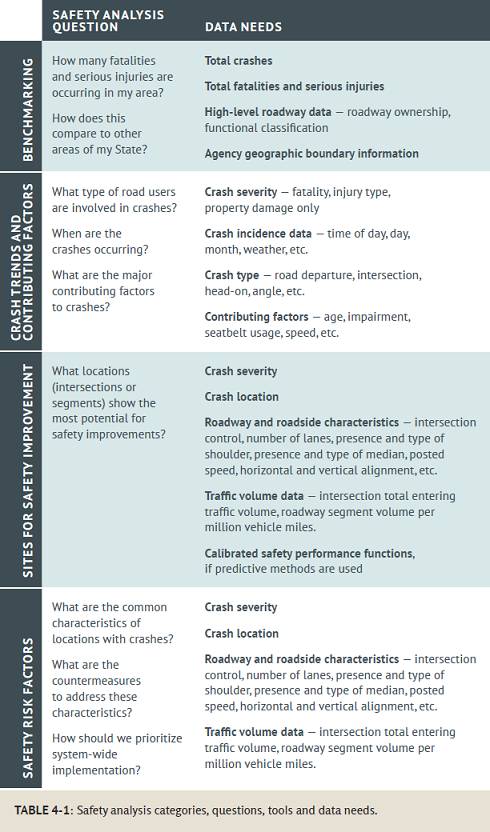
| Safety Analysis Question | Data Needs | |
|---|---|---|
| Benchmarking |
How many fatalities and serious injuries are occurring in my area? How does this compare to other areas of my State? |
Total crashes Total fatalities and serious injuries High-level roadway data - roadway ownership, functional classification Agency geographic boundary information |
| Crash Trends and Contributing Factors |
What type of road users are involved in crashes? When are the crashes occurring? What are the major contributing factors to crashes? |
Crash severity - fatality, injury type, property damage only Crash incidence data - time of day, day, month, weather, etc. Crash type - road departure, intersection, head-on, angle, etc. Contributing factors - age, impairment, seatbelt usage, speed, etc. |
| Sites for Safety Improvement | What locations (intersections or segments) show the most potential for safety improvements? | Crash severity Crash location Roadway and roadside characteristics - intersection control, number of lanes, presence and type of shoulder, presence and type of median, posted speed, horizontal and vertical alignment, etc. Traffic volume data - intersection total entering traffic volume, roadway segment volume per million vehicle miles. Calibrated safety performance functions, if predictive methods are used |
| Safety Risk Factors |
What are the common characteristics of locations with crashes? What are the countermeasures to address these characteristics? How should we prioritize system-wide implementation? |
Crash severity Crash location Roadway and roadside characteristics - intersection control, number of lanes, presence and type of shoulder, presence and type of median, posted speed, horizontal and vertical alignment, etc. Traffic volume data - intersection total entering traffic volume, roadway segment volume per million vehicle miles. |
RSPCB Program Point of Contact
Felix Delgado, FHWA Office of Safety
Felix.Delgado@dot.gov
FHWA Office of Safety
Staff and Primary Work Responsibilities
FHWA Office of Safety
Safety and Design Team
FHWA Resource Center